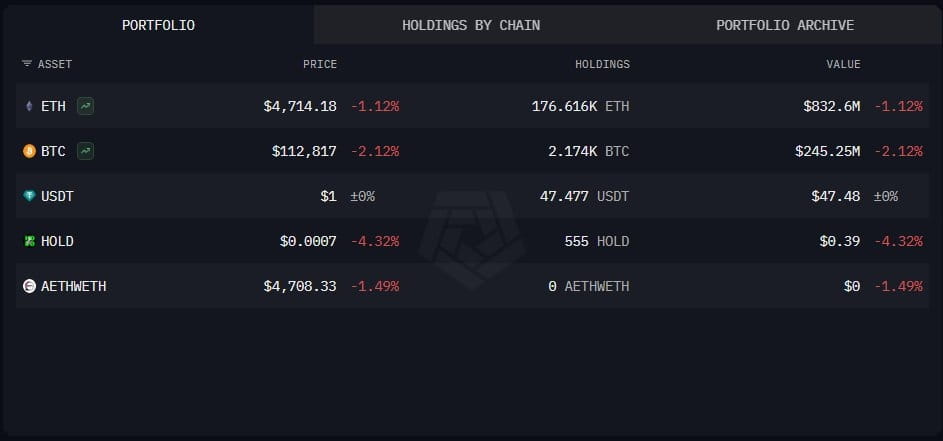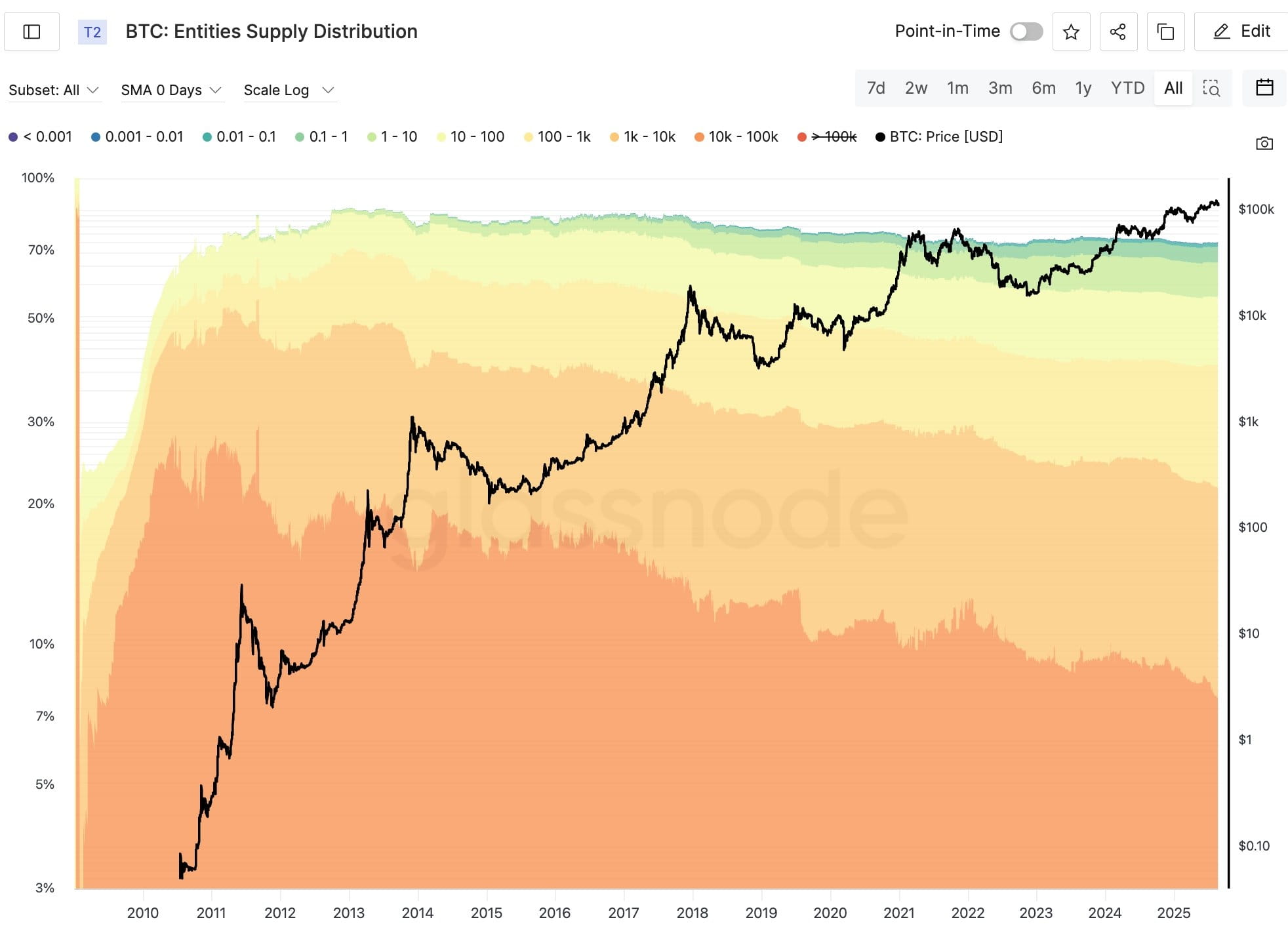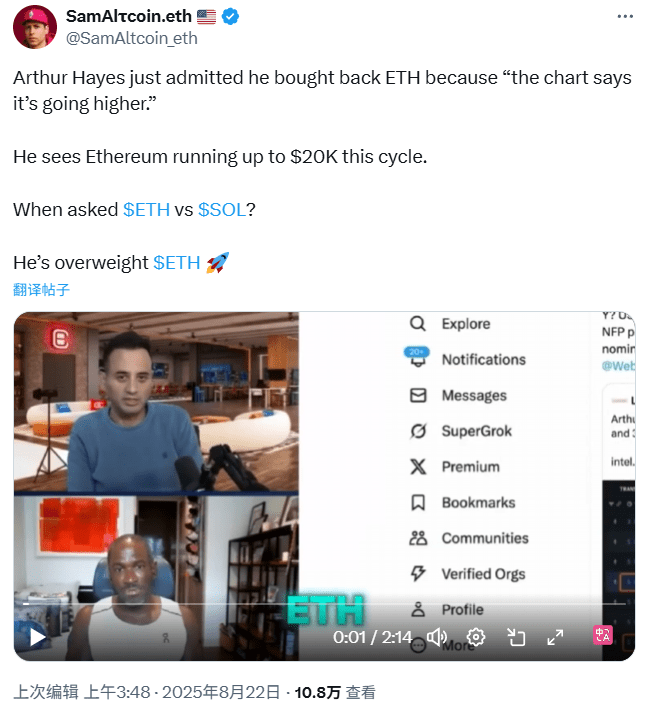Written by: Oliver, Mars Finance
On August 25, 2025, the crypto market witnessed a historic moment. According to Onchain Lens monitoring, an ancient whale with a mysterious identity but whose holding history can be traced back to Bitcoin's genesis executed a jaw-dropping operation: selling nearly 20,000 BTC (worth about $2.22 billion) and exchanging it entirely for over 450,000 ETH, most of which (about $1.13 billion) was quickly staked in the Ethereum PoS network.

This action is like a starting gun, instantly igniting the market's imagination. It is no longer just a simple 'take profit' because funds are not flowing out of the crypto ecosystem, but are precisely injected from one end of the ecosystem's 'value storage' to the other end of 'value generation.' Meanwhile, the market's candlestick chart has long since responded: the ETH/BTC exchange rate has steadily risen since May this year, indicating Ethereum's continued strength relative to Bitcoin.
Is this whale's repositioning a solitary speculative move, or does it represent a collective shift of 'smart money'? Does it validate analyst Willy Woo's theory of 'Bitcoin's growing pains'? And how will it resonate with Arthur Hayes's prophesied 'trillion-dollar migration of stablecoins'? This article will start from this 'century transaction', layer by layer, to explore the structural paradigm shift occurring in the crypto world.
I. Stunning repositioning: decoding the 'asset attribute' revaluation behind $2.2 billion
To understand the profound implications of this repositioning, we must go beyond the fluctuations in price and delve into the core of its asset attributes.
Firstly, this is a strategic shift from 'non-productive assets' to 'productive assets.'
The core value of Bitcoin lies in its undisputed digital scarcity and decentralization, making it a 'digital gold' against fiat currency inflation. However, holding Bitcoin itself (without considering derivatives like lending) does not generate intrinsic cash flow. It is a passive value storage tool, and its returns entirely rely on the increase in market prices.
Ethereum in staking (Staking) is completely different. By staking ETH to maintain the network's security, holders can receive ongoing rewards denominated in ETH. This makes ETH a 'productive asset' or 'digital bond' that can generate predictable real yields. This whale immediately staked more than half of the ETH after repositioning, making its intentions clear: what it seeks is no longer merely the appreciation potential of assets but a continuous and stable cash flow. This marks a transition in the wealth concept of early crypto millionaires from purely capital gains to a more mature, traditional finance-like 'yield' model.
Secondly, this confirms Willy Woo's 'ancient selling pressure' theory and reveals the ultimate destination of the funds.
Willy Woo's perspective is incisive: the slow rise of Bitcoin this round is due to the whales who built their positions at less than $10 around 2011 selling. For every BTC they sell, the market needs to inject over $100,000 in new funds to absorb it. This poses a massive resistance to Bitcoin's upward movement.

This whale's repositioning is a perfect real-world interpretation of this theory. But it goes a step further; it tells us that the massive liquidity converted from these 'ancient selling pressures' has not escaped the market but has chosen Ethereum as a new 'reservoir.' This forms a stark contrast:
Bitcoin side: Ancient supply has been activated, creating a continuous selling pressure, and the market needs to continuously digest the 'historical burden.'
Ethereum side: absorbed a huge amount of existing funds from the Bitcoin ecosystem and immediately converted it into the network's 'moat' through staking, reducing market circulation.
This 'outflow and inflow' dynamic is the most direct and hardcore explanation for the strengthening ETH/BTC exchange rate.
II. Two sides of the same coin: Bitcoin's 'growing pains' and Ethereum's 'ecosystem flywheel'
The whale's actions are the effect; the fundamental differences behind them are the cause. Bitcoin and Ethereum are currently at two completely different stages of development and narrative trajectories.
Bitcoin's 'sweet troubles': the mature cost of digesting ten-thousandfold returns
As the pioneer, Bitcoin's greatest success—creating unprecedented investment returns in human history—has now become its 'sweet trouble' in continuing to move forward lightly. The enormous unrealized gains of early participants hang over the market like the Sword of Damocles. Every market rise triggers some of the 'ten-thousandfold earners' to cash out or rebalance assets. This process is an inevitable path for Bitcoin to achieve full maturity and fully circulate its chips, representing its 'growing pains.' Until this stage is completed, Bitcoin's price performance will inevitably appear relatively 'heavy.'
Ethereum's 'ecosystem flywheel': endogenous growth driven by three engines
Unlike Bitcoin's 'stock game', Ethereum exhibits strong 'incremental' characteristics, with its value capture driven by a positive flywheel composed of three engines.
The supply black hole of PoS staking: the latest validator queue data shows that despite the profit-exiting queue (about 846,000 ETH), the queue waiting to enter staking is surging (from 150,000 to 400,000 ETH). This indicates that a new wave of institutions and long-term investors, represented by listed companies like SharpLink and BitMine, are embracing ETH staking yields with unprecedented enthusiasm. The staking mechanism acts as a massive 'supply black hole,' continuously converting circulating ETH into a locked state, structurally reducing market selling pressure.
Network effects of the stablecoin settlement layer: Token Terminal data shows that the usage of USDC on Ethereum has reached an all-time high, with monthly transfer amounts nearly $750 billion, comparable to large banking systems. This reveals one of Ethereum's core value propositions: it is becoming the underlying settlement network for the global digital dollar economy. Every stablecoin transfer and every DeFi interaction requires consuming ETH as gas fees, and a portion is destroyed through the EIP-1559 mechanism. This demand based on 'real economic activity' provides solid value support for ETH, making it no longer just a speculative tool.
The deflation narrative of 'ultrasound money': under the dual effects of staking lock-up and gas fee burning, Ethereum's net issuance can turn negative during busy network times, entering deflation. This 'less is more' currency model, known as 'ultrasound money,' provides a new value narrative comparable to Bitcoin's 'digital scarcity,' and this scarcity is dynamic and positively correlated with ecosystem prosperity.
These three engines mutually reinforce each other, forming a powerful 'ecosystem flywheel': the more prosperous the ecosystem -> the higher the gas consumption and staking demand -> the stronger the ETH deflation and tighter the supply -> the higher the expected price -> attracting more funds and builders into the ecosystem, in a continuous loop.
III. Macroeconomic winds: Arthur Hayes's $13 trillion stablecoin prophecy
If the whale's repositioning is a tactical signal, Ethereum's ecosystem flywheel is the strategic foundation; then former BitMEX co-founder Arthur Hayes's macro insights provide the ultimate catalyst for this 'great rotation.'
Hayes pointed out at the WebX conference that the core driving force of the upcoming crypto bull market in the coming years will stem from geopolitical and fiscal demand in the United States. He predicts that the U.S. will actively guide a European dollar market worth $10-13 trillion back into its controllable, blockchain-based stablecoin ecosystem. The significance of this assertion is disruptive; it indicates that the crypto market is about to receive massive liquidity measured in 'trillions' from the global traditional financial system.
And Hayes is not just a prophet but also an action-oriented individual. Just last week (August 22), he publicly stated that he personally repurchased Ethereum and set an astonishing target of 'reaching $20,000 in this cycle.' This strong bullish signal was immediately responded to by institutions; the listed company BitMine, which is actively staking ETH, promptly shared Hayes's interview in agreement.

This makes the answer self-evident: when this tide of stablecoins needs an efficient, safe platform with deep financial LEGO blocks (DeFi), Ethereum and its prosperous Layer 2 networks are the only choice.
At this moment, all clues converge: when hundreds of billions of dollars in stablecoins flood into the Ethereum ecosystem seeking yield (like Ethena) and trading (like Hyperliquid), the demand for the underlying asset ETH will be exponentially amplified. That ancient whale not only staked a massive amount of ETH but also precisely planned to 'continue selling BTC for ETH on HyperLiquid,' perfectly stepping in time with Hayes's predictions.
His actions clearly indicate: he is not only purchasing the staking base yield of ETH but also positioning himself with the enormous sum of $2.2 billion, anticipating a new DeFi summer ignited by stablecoin liquidity.
Conclusion: Embracing the paradigm shift of value accumulation
Returning to our initial question: what does the stunning repositioning of a $2.2 billion whale signify?
It signifies a profound paradigm shift in the value assessment system of the crypto world. While the investment logic of 'value storage' relying solely on grand narratives and digital scarcity remains solid, the balance of capital is tipping towards 'productive assets' that can generate real yields, support complex economic activities, and capture network value.
We are transitioning from an era dominated by 'HODL' culture to one defined by 'Yield' (returns) and 'Utility' (utility).
This 'great rotation' does not signal the end of Bitcoin. As the most decentralized and censorship-resistant medium of value storage, its status as 'digital gold' is unshakeable and will continue to play a foundational role in macro hedging and asset allocation. However, in terms of growth elasticity and capital efficiency, the market's spotlight is irreversibly turning to Ethereum.
For investors and industry observers, understanding this rotation is key to grasping this cycle. The ETH/BTC exchange rate is no longer just a trading pair; it is a mirror reflecting the evolution path of the crypto world from 1.0 to 2.0. That ancient whale, using the wealth accumulated since Bitcoin's inception, cast the heaviest and most credible vote for this path. And this may just be the beginning.



